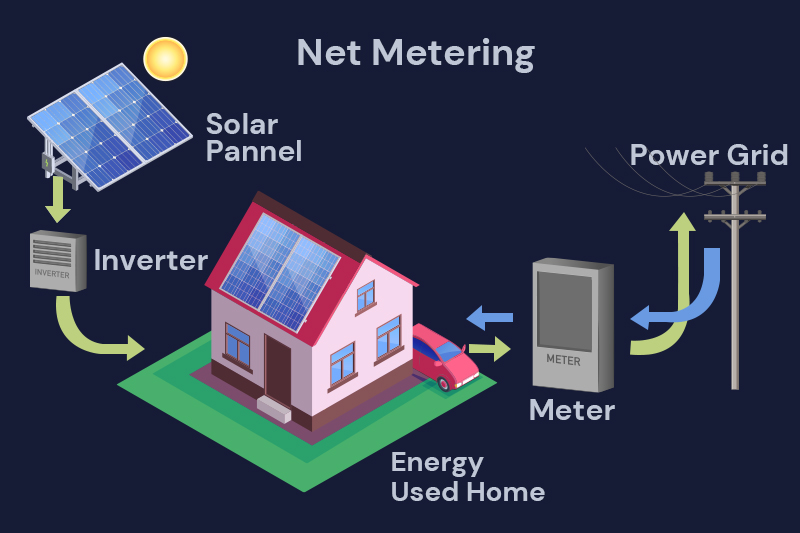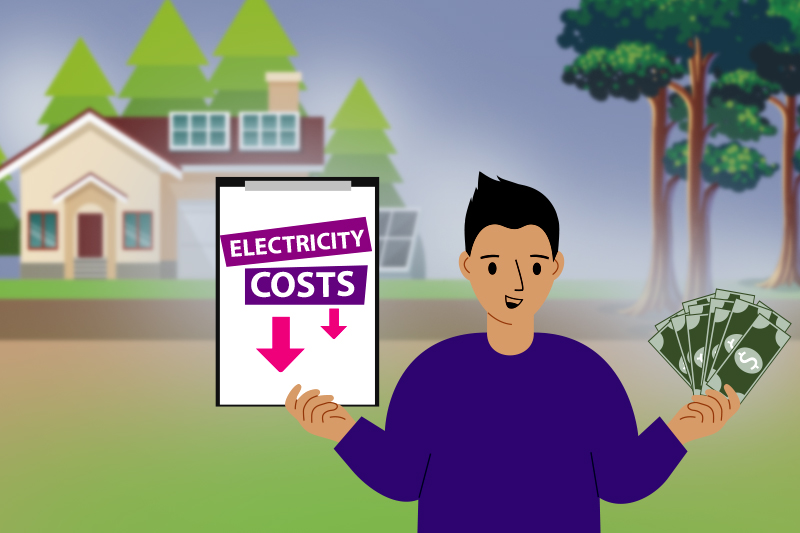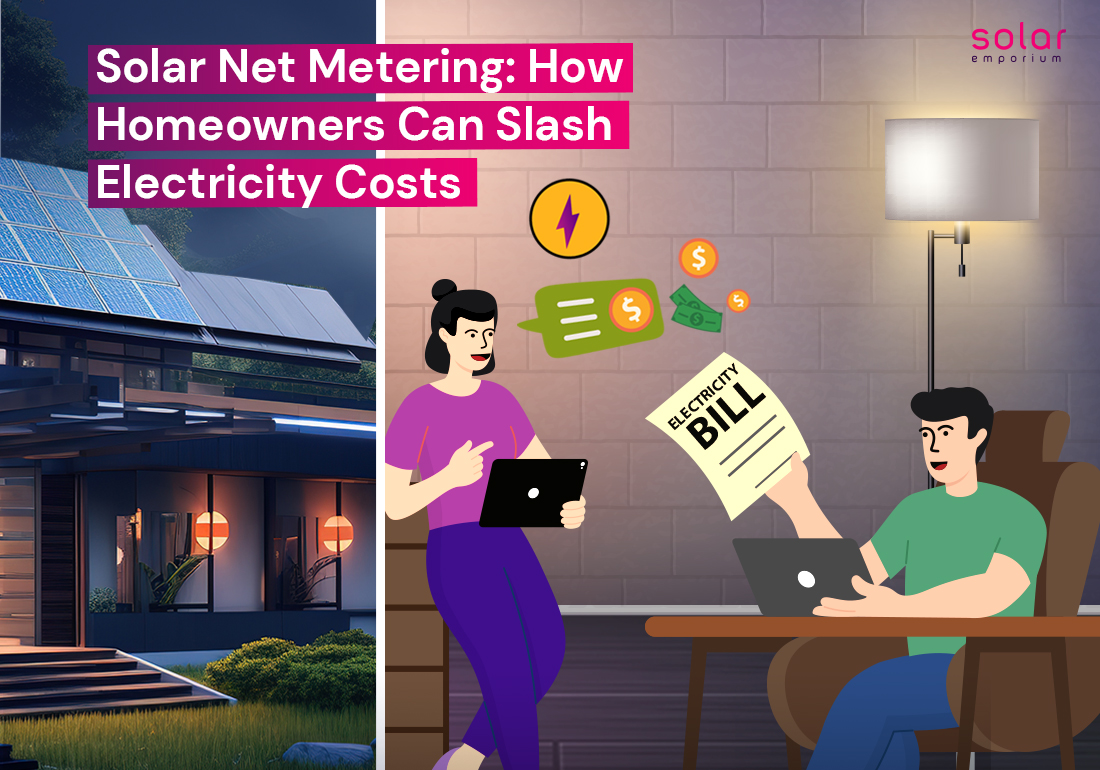If you have solar panels on your roof, you use up only some of the energy they make. The extra power goes to the electricity grid your utility company manages.
And solar net metering is how homeowners can slash electricity costs.
If you didn’t get anything for this extra energy, having solar panels might not be worth it. Solar storage can help you save this excess energy for later, but there’s an easier and cheaper option.
Solar net metering is how your utility company pays you for the electricity your solar panels make but you don’t use. It’s the most common way, but there are a few others.
Putting solar power into the grid won’t make you rich each month, but learning about it beforehand could help you pay off your solar panels in the long run.
We’ll explain all the options so you can understand how they help you save money and pay for your solar panels faster.
What is Net Metering?
A net meter is a tool that tracks how much electricity your home uses. It shows how much energy your home makes and uses. It also helps you figure out if your home needs more solar power.
With net metering, the meter can count backward. So, you only pay for the difference between what you use and what your solar panels produce.
Your solar panels can give electricity back to the grid regularly. Depending on your net meter type, this can happen every 30 minutes or once a day.
If you install solar panels in Australia, you might not get net metering or other benefits. You need a professional to install and connect your solar panels to the grid.
Net metering is a way to ensure you get credit for the extra power your solar panels make and give to the grid for others to use.
Your electricity meter measures how much electricity you take from the grid. Net metering also counts how much electricity your solar panels send back, which can lower your bill.
Usually, your meter can count both ways. At the end of the month, you just pay for what you use from the grid.
This lets you use electricity from your solar panels during the day and from the grid at night or when your solar panels can’t make enough.
Understanding Solar Net Metering
Many governments want people to use solar power at home to use less fossil fuels.
But just relying on solar power might not give enough energy for a home. Solar panels only make electricity when the sun is out. People might need more ways to produce electricity. And the batteries for solar energy can be expensive at first.
The best way is to connect solar panels to the electricity grid. This lets the meter give and take power. Different ways of measuring electricity are used for other payment plans and bonuses.
One way is called net metering. It uses a meter that counts both ways. People only pay for their electricity after taking away what they make. They get credit for the extra at certain prices and conditions if they make more than they use.
Another way is dual metering, where people have two meters that only count one way. They can send all the electricity they make back to the grid. This is helpful when the appliances use electricity from the home’s maker at a different price than the grid.

The utility’s price for extra electricity is called the feed-in tariff (FiT). Australia’s FiT program has changed, and now the prices are lower, so people make just enough energy for themselves.
Because of net metering, regular homes and businesses can use solar power while connected to the grid. Net metering rewards people who use solar panels and connect to the grid.
Net metering is used in many countries. People with solar panels expect to be paid a reasonable price, like regular grid electricity.
In Australia, extra electricity made by solar panels is balanced with the market price of electricity. So, electricity bills are calculated by taking away how much electricity people use from how much their solar panels make.
Benefits of Solar Net Metering
Cost Savings:
Financial Incentives:
Flexibility:
Environmental Benefits:
Grid Stability:
How Homeowners Can Slash Electricity Costs with Solar Net Metering?
Homeowners can significantly reduce electricity costs by using solar net metering programs. By installing solar panels on their roofs, homeowners can generate clean energy during the day when the sun is shining.
Any excess electricity produced by the solar panels is sent back to the grid through net metering, effectively spinning their electricity meters backward.
This surplus energy is credited to their electricity bills, offsetting the cost of electricity consumed during periods when solar production is insufficient, such as at night or on cloudy days.
This process allows homeowners to slash their electricity costs by reducing their reliance on grid-supplied electricity and earning credits for the surplus energy they contribute.

Moreover, solar net metering provides homeowners with long-term financial benefits. While the initial investment in solar panel installation may seem daunting, the savings generated over time can be substantial.
With net metering, homeowners reduce their electricity bills and enjoy the potential for earning additional income through feed-in tariffs, where they are paid for the excess electricity they produce.
This financial incentive encourages homeowners to invest in renewable energy solutions, promoting sustainability while bolstering their household finances.
Ultimately, solar net metering empowers homeowners to take control of their energy usage, mitigate electricity costs, and contribute to a greener and more sustainable future.
Calculating Net Metering Saving
Determine Your Solar Energy Production:
First, you need to know how much energy your solar panels produce. This information can be obtained from your solar panel system’s monitoring software or inverter.
Understand Your Electricity Consumption:
Compare Production and Consumption:
Compare the amount of energy your solar panels produce with your household’s energy consumption.
If your solar panels generate more power than you use, the excess energy is typically sent back to the grid.
Calculate Credits or Payments:
With net metering, you earn credits or payments for the excess energy you send back to the grid.
The rate you’re credited varies depending on your electricity retailer and your area’s feed-in tariff (FiT). Check your electricity bill or contact your retailer to determine the FiT rate you’re eligible for.
Estimate Savings:
To estimate your savings, multiply the excess energy you send back to the grid by the FiT rate. Subtract this amount from your total electricity bill to determine your net savings due to net metering.
Net metering savings can vary depending on factors such as the size of your solar panel system, your household’s energy consumption patterns, FiT rates, and any additional fees or charges from your electricity retailer.
Consulting with a solar energy provider or financial advisor can help you assess your net metering savings potential accurately.
Net Metering Policy in Australia

In Australia, net metering policies vary depending on the state or territory. Generally, net metering allows homeowners with solar panels to feed excess electricity they generate back into the grid and receive credits on their electricity bills.
These credits can then be used to offset the cost of electricity consumed from the grid when solar production is insufficient.
Each state and territory has its own rules and regulations regarding net metering. Some regions offer a one-for-one credit system, where homeowners are credited at the same rate they are charged for electricity consumed from the grid.
Others may have different rates for exporting and importing electricity, known as gross metering.
Feed-in tariffs (FiTs) are also often part of net metering policies. FiTs pay homeowners for the excess electricity they generate and feed into the grid. The rates for FiTs can vary widely depending on location and government policy.
While net metering policies in Australia aim to incentivize the adoption of solar energy and reduce electricity costs for homeowners, the specific details and benefits can differ significantly between states and territories.
It’s essential for homeowners considering solar installations to research and understand the net metering policies and FiT rates applicable to their location.







